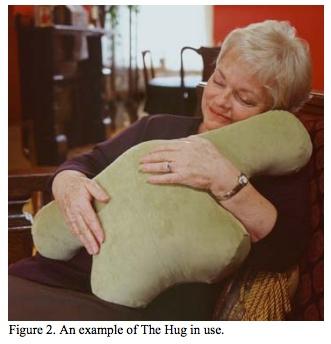For us humans, hugging is vital because it applies pressure on the nerves around our bodies, releasing the stress and giving us a feeling of safety. Microsoft apparently knows this because they have been awarded a patent on “Force-feedback within telepresence,” the idea of using responsive high-tech devices to bring physical interactions to long-distance communications. Originally submitted for consideration in 2009, the patent (8,332,755) was approved by the USPTO earlier this month.
For example, the patent says, “Hugs, hand-shakes, grabbing documents, writing on a whiteboard, and the like can be detected so a specific feedback force response is implemented.”
Force feedback is common in video game controllers these days, and this idea of extending it to long-distance interactions isn’t new. For example, researchers from Carnegie Mellon in 2003 presented a paper called “The Hug: An Exploration of Robotic Form For Intimate Communication.”

“Mary lives in Chicago and her granddaughter, Chrissy, lives in Pittsburgh. They use The Hug to stay connected. One evening while sitting in her living room, Mary hears her, Hug’s melody and sees a warm glow in its belly, signalling that someone is sending her a hug. She picks up her Hug, squeezes its left paw and says “Hello.” She hears her granddaughter Chrissy respond “Hello Grandma.” As Mary and Chrissy chat, Mary strokes the back of her Hug, causing Chrissy’s Hug to vibrate softly. As time passes, their Hugs begin to slowly warm, radiating a comfortable heat. Once they are done chatting, Mary says goodbye, and squeezes her Hug’s right paw. The Hug plays another melody and glows, signalling that this hug has ended.”
Microsoft doesn’t tell the story this way but it covers more than that type of scenario. For example, the patent describes a handshake scenario: If someone on one end of the line shakes a device forcefully, that shake is felt with more force by the person holding a counterpart device on the other end of the line.
Microsoft also says the feedback could include “friction, haptic, tactile, electric feedback, electrical stimulation, three-dimensional feedback, vibration, shaking, physical resistance, temperature change, motion, noise, pressure, texture, a motion, a replication of touching, any combination thereof, and/or any other suitable feedback communicated via a device.”
I know what you’re thinking, you naughty tH’ers, unfortunately, Microsoft’s patent doesn’t go there, at least not explicitly.
It can be tough to stay connected over long distances and sometimes phone calls, texting, Facebook, Twitter, IM, video chatting may not be enough but with this technology, Microsoft may bring us closer to our loved ones.
N.

